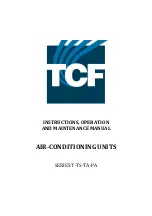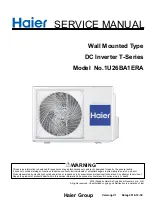
5.
All duct designs and heat loads must be calculated
by a qualified air conditioning consultant or
contractor in accordance with normal good ducting
practices.
Dimensions of duct connections are shown on the
dimension sheet. Connection to the unit must be
made via flexible connections to prevent
transmission of vibration and facilitate easy removal
of panel work for major service access. All ductwork
must be insulated against noise and heat
transmission.
6. FRESH AIR
INTAKE
If required this must be fitted to the return air ducting
as no special provision is made within the unit. All
fresh air intakes must be provided with air filters if
they are connected to the ductwork between the
return air filter and the unit.
Consideration should be made to the return air
sensor. The ducted units have a return air sensor
mounted near the return air coil. Fresh air influences
may affect the room temperature. Relocating the
position of the return air sensor may be required.
7. AIR FILTERS – DUCTED SYSTEMS
Air filters are not provided and no provision is made
for fitting them within the unit as standard. Air filters
should however be provided by the installing
contractor and located in an accessible location
between the return air grille and the unit. These filters
must be sized for a maximum face velocity of 2.0
m/sec.
8. REFRIGERANT
LINES
The refrigeration installation, evacuation & charging
must be carried out by a competent licensed
refrigeration mechanic in accordance with local
authority regulations & compliance.
New, clean, moisture free refrigerant quality copper
tube must be used when piping up the unit.
Correct size tube
MUST
be used at all times.
Maximum permissible line runs and maximum
permissible vertical lifts must never be exceeded to
avoid the risk of loss of warranty.
8.1 Using specified diameter tubing, run liquid and
gas lines from the outdoor unit to the indoor
unit avoiding hot surfaces such as hot water
pipes, boiler, flues, etc.
8.2 The refrigerant piping should be as short and
straight as possible to obtain the most efficient
performance.
8.3 All vertical gas rises must be fitted with an oil
trap every 5 metres, when outdoor unit is
above the indoor unit.
8.4 Both lines should be insulated separately
along its entire length with a water and rodent
resistant material such as Ensolex or
Armaflex.
Insulate both refrigerant lines
separately.
8.5 Both lines must be adequately supported to
prevent vibration. Maximum recommended
support centres are:
Line Size
Max. Support Centres
12.7 OD
1.6M
15.9 OD
1.8M
28.9 OD
2.0M
34.9 OD
2.6M
8.6 When soldering joints the system must be
purged with dry nitrogen to prevent oxidation
of pipework.
9. LEAK
TESTING
9.1 Charge the system with R22 vapour to 200
kPa gauge pressure.
9.2 Boost the pressure in system to 1400 kPa with
nitrogen or dry air.
9.3 Conduct a leak test at all system joints and
components and repair leaks as required.
10. EVACUATION
10.1 Evacuate the system for minimum of 2 hours
to 500 microns with a vacuum pump.
10.2 Stop the vacuum pump, close the valves and
wait for 30 minutes and check for pressure
rise.
•
If the rise in pressure is no more than 50
microns then the system is leak free.
•
If the pressure rise is more than 50 microns,
this indicates the presence of contaminants
and/or leaks in the system.
Repeat leak test, repair and evacuation
procedures.
11. CHARGING THE SYSTEM
11.1 Open both Suction & Liquid line service valves
to release refrigerant
11.2 The condensing unit is precharged for up to
6m of refrigeration pipe.
11.3 Weigh the specified amount of additional line
charge of R22 into the charging cylinder.
11.4 Run the unit and bleed the remaining
refrigerant vapour through the suction line.
Close off the charging line valve and carry out a leak
test to all pipe joints.
WARNING
DO NOT UNDER ANY CIRCUMSTANCES
RECHARGE THIS EQUIPMENT WITH FLAM-
MABLE HYDROCARBON REFRIGERANTS.
THE USE OF FLAMMABLE HYDROCARBON
REFRIGERANTS CAN CAUSE EXPLOSIONS.
INSTALLATION - cont
Page
2
Summary of Contents for K CassetteSeries
Page 14: ...RC4 REMOTE CONTROL Page 12...
Page 15: ...RC4 MODES OF OPERATION FUNCTIONS FEATURES Page 13...
Page 16: ...Page 14...





































